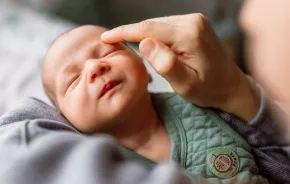 One thing we learn early on is that practice makes perfect. Or at least, practice makes us better. So when parents who have successfully delivered one or more healthy babies discover they can't get pregnant again, it comes as a shock.
One thing we learn early on is that practice makes perfect. Or at least, practice makes us better. So when parents who have successfully delivered one or more healthy babies discover they can't get pregnant again, it comes as a shock.
Those set on multi-child families can feel heartbroken, caught between those who have never been able to conceive and friends whose children have siblings. Inevitably, couples dealing with secondary infertility are questioned, even by strangers wanting to know if they intend to raise an only child or have more children.
"Our society is funny in that way," says Diane Lostrangiaolo, a Seattle mother. "We don't ask personal questions about money, but about children, people feel they can ask and probe."
Lostrangiaolo and her husband started trying to have a second child when their biological son was 3 years old. "People would ask questions and it would bother me so much," she recalls. "I wouldn't show it right there, but when I got home, I would fall apart."
What is secondary infertility?
Secondary infertility is defined as a couple's inability to conceive after a year of unprotected and appropriately timed intercourse when one or both partners have previously had children.
In reproductive medicine circles, even two miscarriages classify a woman as experiencing "recurrent pregnancy loss." In this situation, as with an inability to conceive at all, couples are advised to seek help from a reproductive specialist.
Seattle fertility expert Lee Hickok, M.D., finds that many couples are in a state of disbelief when they are not able to conceive again. "It helps them to know that others are like them," adds Hickok of Pacific Northwest Fertility and IVF Specialists, which is closely affiliated with Swedish Medical Center. Between 60-70 percent of the couples seeking treatment at the clinic face secondary, rather than primary, infertility.
While "there is a better chance that someone will get pregnant in cases of secondary infertility," Hickok says, the diagnosis and treatment of both kinds of infertility are the same. Is the female partner is ovulating normally? Does the male partner have a normal semen analysis? In about half of the cases, the cause of infertility is attributable to the male.
Factors in secondary infertility
Secondary infertility often brings other issues into play, including the mother's weight (obesity interferes with ovulation) and progressive conditions such as endometriosis. Still, the single biggest factor in secondary infertility is the female's age.
Consider the numbers, for they are staggering. When a woman is 30 years old, there is a 20 percent chance that well-timed sex will lead to conception. By the time a woman is 45 years old, the likelihood that well-timed sex will lead to conception is a mere 1 percent, according to Hickok. His sketch of how a woman's fertility declines after age 30 looks similar to a drive down Hurricane Ridge. It is a steep descent, and were it not for modern medicine, it would be irreversible.
What are the options?
The good news for all infertility patients, secondary and primary, is that this field has made enormous strides in the past two decades. Fertility drugs remain the first solution for women with ovulation problems. These are taken either orally or injected.
As a last resort, there is in vitro fertilization (IVF), which involves combining the eggs and sperm in a lab. Once embryos are developed, they are placed into the uterus. While a medical intern in 1984, Hickok helped deliver the first baby conceived by IVF. Then, the success rate for embryo transfer was 20 percent. Now, it is about 50 percent. But the process isn't cheap. With the accompanying medications, each IVF treatment runs about $13,000.
Adoption as an option
Years after they discovered they could not bear another baby of their own, Diane Lostrangialo and her husband pursued an international adoption. Lostrangiaolo, the executive director of New Hope Child and Family Agency in Shoreline, became comfortable with the idea of adoption more quickly than her husband. Looking back, she describes that as a difficult period in their lives. After many prayers, tears and heart-to-heart talks, the couple was ready to move forward. "It took my husband many years to get to the place of being there to make it work," she adds
In her role at New Hope, Lostrangialo advises parents with their own biological children on the struggles and strengths of adoption. "Those parents know more about the risks of pregnancy," Lostrangialo says. "In cases of domestic adoption, it can be very difficult for a parent who carried a child and was intentionally very healthy to transition to a case that might involve prenatal exposure to drugs or alcohol."
In their book, A Few Good Eggs: Two Chicks Dish on Overcoming the Insanity of Infertility, authors Julie Vargo and Maureen Regan advise women to gather as much information as they can and find a doctor who will listen to your needs. They add: "Fasten your seatbelts. It's a bumpy road ahead."
Still, statistics offer hope, Hickok notes: For nearly three-fourths of the couples wishing for more children, that road can indeed lead to a bigger family.
Hilary Benson lives in the Seattle area. Her work has appeared in ParentMap and Metropolitan Living magazine. She has also reported for KING-5 TV.
Resources
Dr. Hickok recommends the following resources for parents experiencing secondary infertility:
- National Infertility Association: This national group offers local support groups, including one in Seattle, weekly online chats and a telephone helpline service at 888-623-0744. Web site is www.resolve.org
- American Society of Reproductive Medicine: www.asrm.org. This Web site is more technical and geared toward professionals in the field.
- Taking Charge of Your Fertility, by Toni Weschler
- Adopting: Sound Choices, Strong Families by Patricia Irwin Johnston











